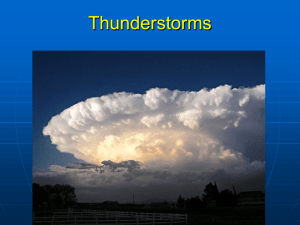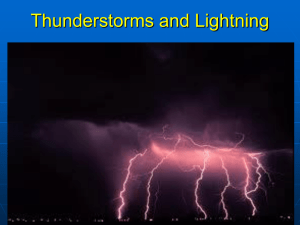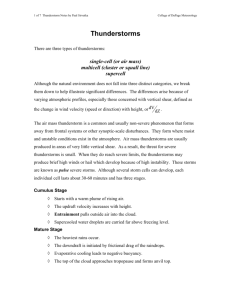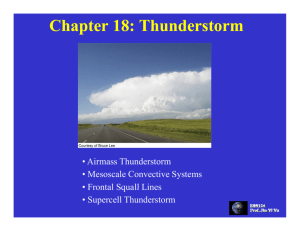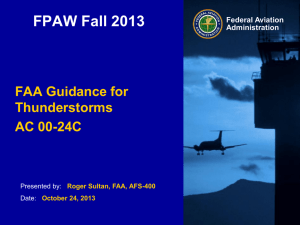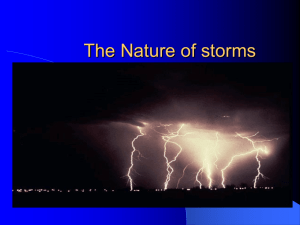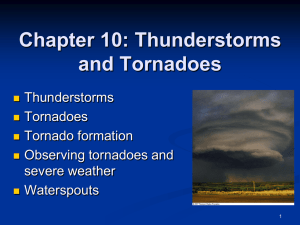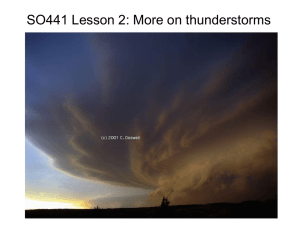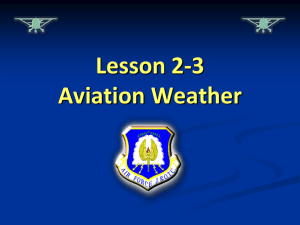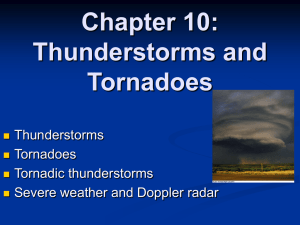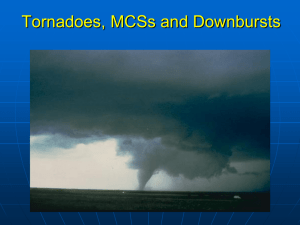Thunderstorms
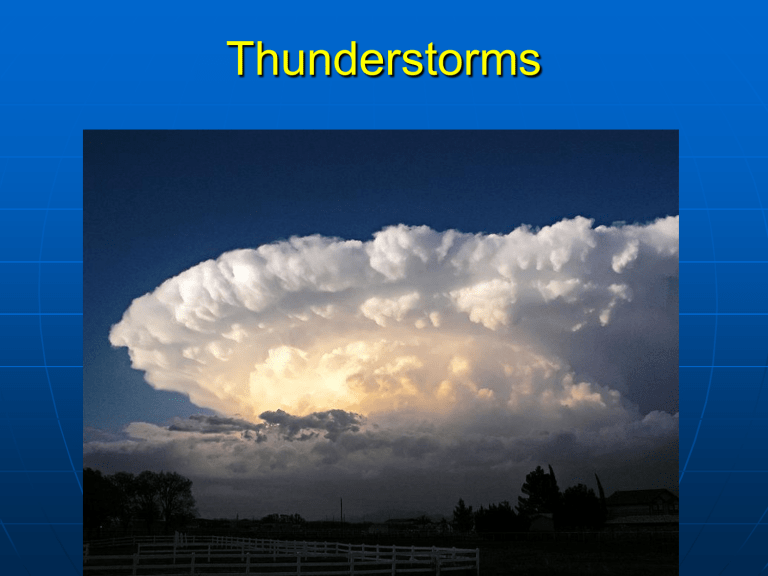
Thunderstorms
Review of last lecture
1. Two types of lightning (cloud-to-cloud 80%, cloud-toground 20%)
2. 4 steps of lightning development.
3. How fast does thunder travel?
4. Climate impacts of lightning: nitrogen cycle, ozone, wildfire
5. Lightning safety
Convective systems
Tornadoes: about 100-600 m , last 1 minute to 1 hour
Thunderstorms: about 10 Km , last 10 minutes to a couple of hours. 3 types: ordinary, multicell, supercell
Mesoscale convective systems (MCSs): A cloud system that occurs in connection with an ensemble of thunderstorms and produces a contiguous precipitation area on the order of 100 Km or more in at least one direction , and often last for several hours to a couple of days .
Thunderstorms
A storm containing lightning & thunder
Convective ; form when warm, humid air rises in conditionally unstable environment
The warmer the rising air parcel is relative to environment, the more buoyant force is driving it upwards (stronger convection)
Trigger to start uplift: warming sfc, terrain
(orography), converging sfc winds, frontal zones, divergence aloft (or combination)
Thunderstorms I. Ordinary Storms
Three stages have been identified in ordinary thunderstorms: a) DEVELOPING : unstable atmosphere, vertical updrafts keep precipitation suspended b) MATURE : entrainment of dry air that causes cooler air from evaporation, triggering downdrafts and falling precipitation and gust fronts c) DISSIPATING : weakening updrafts and loss of the fuel source after 15-30 minutes.
An ordinary thunderstorm
Thunderstorms II. Multicell Storm
Cool downdrafts leaving a mature and dissipating storm may offer relief from summer heat, but they may also force surrounding, low-level moist air upward.
Hence, dying storms often trigger new storms, and the successive stages may be viewed in the sky.
A Multicell Thunderstorm
Video: Supercell thunderstorm
http://www.youtube.com/watch?v=UBTb5
Yd20cM
Thunderstorm III. Supercell Storm
Storms producing a minimum of a) 3/4 inch hail and/or b) wind gusts of 50 knots and/or c) tornado winds, classify as severe.
Formation of supercell thunderstorms
1. Before thunderstorms develop, a change in wind direction and an increase in wind speed with increasing height creates an invisible, horizontal spinning effect in the lower atmosphere.
2. Spinning horizontal vortex tubes created by surface wind shear may be tilted and forced in a vertical path by updrafts. This rising, spinning, and often stretching rotating air may then turn into a mesocyclone .
3. Most strong and violent tornadoes form within this area of strong rotation.
Vertical structure of a supercell thunderstorm
In ordinary storms, the downdraft and falling precipitation cut off the updraft . But in supercell storms, winds aloft push the rain away and the updraft is not weakened and the storm can continue maturing and maintain its structure for hours.
Cloud structure of a supercell thunderstorm
A Supercell Storm in Texas
Tornado
Horizontal structure of a supercell thunderstorm
Radar echo of a supercell
Satellite image of a supercell
Video: Development of a supercell thunderstorm
http://www.youtube.com/watch?v=36vGiE
5JQzs (90 min -> 2 min lapse)
Different types of supercell thunderstorms
Low precipitation
High precipitation
Effects of supercell thunderstorms
Large hails
Damaging winds
Deadly tornadoes
Flooding
Dangerous cloud-to-ground lightning
Global distribution
Asia
Australia
Europe
North America
South Africa
Video: Multiple tornadoes from one supercell
http://www.youtube.com/watch?v=FPfOyjomig
Summary
1. The general size and lifetime of mesoscale convective systems, thunderstorms and tornadoes
2. 3 types of thunderstorms.
3. 3 stages of the ordinary thunderstorms. Downdraft and falling precipitation cut off the updraft.
4. Formation of multi-cell thunderstorms. Downdrafts initiate new thunderstorms in nearby regions.
1. 3 stages of the supercell thunderstorms. Winds aloft push downdraft/precipitation away and the updraft is not weakened.
